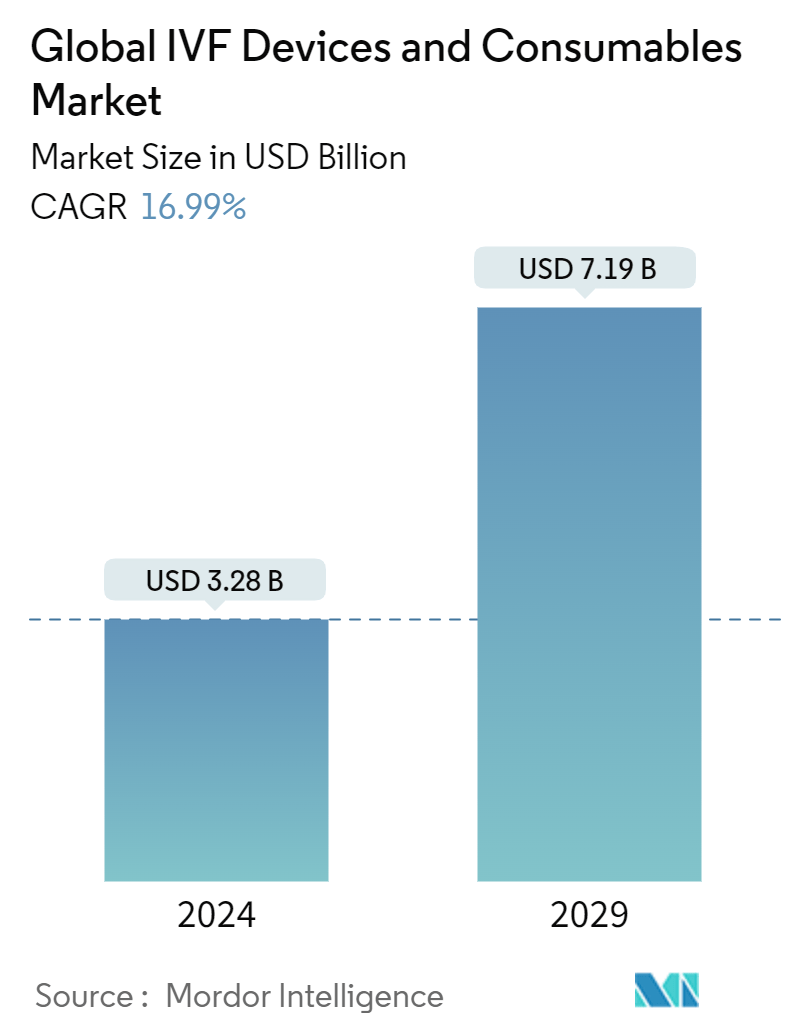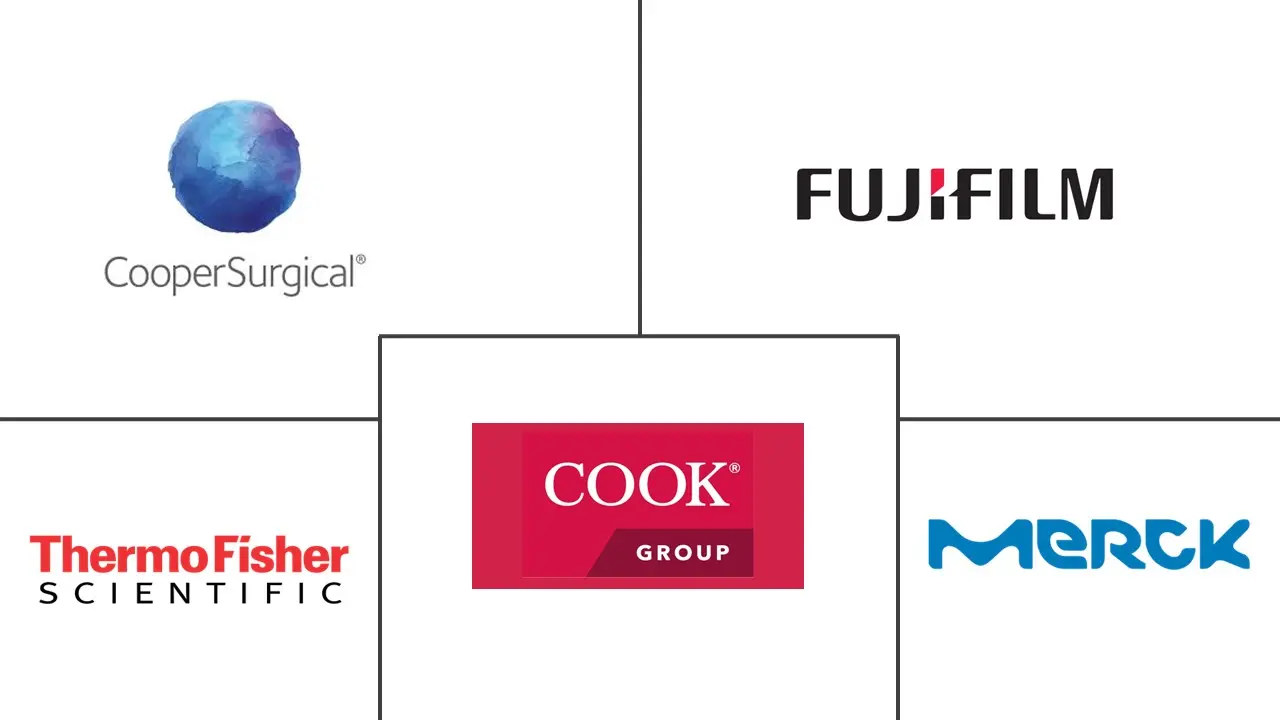Market Size of Global IVF Devices And Consumables Industry

| Study Period | 2019 - 2029 |
| Market Size (2024) | USD 3.28 Billion |
| Market Size (2029) | USD 7.19 Billion |
| CAGR (2024 - 2029) | 16.99 % |
| Fastest Growing Market | Asia-Pacific |
| Largest Market | North America |
| Market Concentration | Medium |
Major Players
*Disclaimer: Major Players sorted in no particular order |
IVF Devices And Consumables Market Analysis
The Global IVF Devices And Consumables Market size is estimated at USD 3.28 billion in 2024, and is expected to reach USD 7.19 billion by 2029, growing at a CAGR of 16.99% during the forecast period (2024-2029).
The key factor driving the market for in vitro fertilization (IVF) devices and consumables is the increasing prevalence of infertility and advancements in reproductive technologies. Further, the rising awareness about infertility treatments, coupled with innovations in IVF techniques and improved success rates, is driving demand for advanced IVF devices and consumables.
Infertility cases are on the rise globally, which will propel the growth of the market during the forecast period. For instance, as per the Center for Disease Control and Prevention updates in April 2024, the general fertility rate in the United States decreased by 3% from 2022. Consequently, rising demand for in vitro fertilization, driven by declining fertility rates, drives market growth. Additionally, government initiatives aimed at combating infertility further bolster this growth. For instance, in August 2024, Japan's Tokyo Metropolitan Government expanded its subsidy program for elective egg freezing to address its declining fertility rate. However, stringent regulations present challenges by mandating written consent from a legal spouse, thereby restricting access for single women and LGBTQ+ professionals. While the program saw a surge in interest with over 7,000 applicants, studies indicate a stark reality: only 15% of women utilize frozen eggs. Hence, these government initiatives to reduce the economic burden of a couple undergoing in vitro fertilization treatment are expected to increase the market share in the upcoming years.
Additionally, the rising research studies for innovation in IVF devices and consumables and increasing product launches contribute to market growth. For instance, in a research study published in the journal of the Royal Society of Chemistry in March 2022, researchers from Florida Atlantic University's College of Engineering and Computer Science developed a microfluidic chip for sperm sorting that is fast, inexpensive, easy to operate and isolates healthy sperm directly from semen. The sperm cells isolated in this microfluidic chip exhibited significantly higher motility, a vital parameter for fertilization. Such advancements in research studies are expected to create a demand for these products to treat infertility, propelling the market growth.
Therefore, the market is anticipated to grow during the forecast period owing to factors such as the high prevalence of infertility and rising research studies leading to technological advancements in IVF devices and consumables. However, the low success rate of IVF procedures and the high cost of devices are likely to impede market growth.
IVF Devices And Consumables Industry Segmentation
As per the scope of the report, in vitro fertilization is a medical procedure whereby an egg is fertilized by sperm in a test tube or elsewhere outside the body. The scope includes medical devices, media, and consumables utilized in the process.
The IVF devices and consumables market is segmented by type, technology, end user, and geography. By type, the market is segmented as instruments, reagents and media, and accessories and disposables. By technology, the market is segmented as fresh embryo IVF, frozen embryo IVF, and donor egg IVF. By end user, the market is segmented as hospitals, fertility clinics, and other end users. By geography, the market is segmented into North America, Europe, Asia-Pacific, the Middle East and Africa, and South America. The market report also covers the estimated market sizes and trends for 17 different countries across major regions globally. The report offers market size and forecasts for the IVF devices and consumables market in value (USD) for all the above segments.
| By Type | ||||||
| ||||||
| ||||||
| Accessories and Disposable |
| By Technology | |
| Fresh Embryo IVF | |
| Frozen Embryo IVF | |
| Donor Egg IVF |
| By End User | |
| Hospitals | |
| Fertility Clinics | |
| Other End Users |
| Geography | ||||||||
| ||||||||
| ||||||||
| ||||||||
| ||||||||
|
Global IVF Devices And Consumables Market Size Summary
The IVF devices and consumables market is experiencing a robust growth trajectory, driven by the increasing prevalence of infertility and advancements in reproductive technologies. The market, which faced significant setbacks during the COVID-19 pandemic due to the suspension of fertility treatments, has been on a recovery path as restrictions have eased and clinics have resumed full operations. The demand for in vitro fertilization is further bolstered by low fertility rates in various regions, such as India and Japan, where government initiatives are expanding insurance coverage for infertility treatments. These efforts aim to alleviate the financial burden on couples seeking fertility solutions, thereby enhancing market growth. Additionally, ongoing research and innovation in IVF technologies, such as the development of microfluidic chips for sperm sorting, are expected to drive the demand for advanced IVF devices and consumables.
The market is characterized by a significant presence of fertility clinics, which are expanding rapidly to meet the growing demand for assisted reproductive technologies. The North American region, in particular, is poised to maintain a substantial market share due to its high availability of infertility clinics and supportive insurance policies for IVF procedures. Strategic initiatives by key market players, including product launches and partnerships, are further propelling market expansion. Despite the high cost of IVF procedures and the challenges associated with low success rates, the market remains partially fragmented with major players like Cook Group and Thermo Fisher Scientific leading the charge. These companies are not only dominating the market in developed regions but are also making inroads into developing countries, leveraging technological advancements and improved connectivity.
Global IVF Devices And Consumables Market Size - Table of Contents
-
1. MARKET DYNAMICS
-
1.1 Market Overview
-
1.2 Market Drivers
-
1.2.1 Increasing Global Infertility Rates and Delayed Pregnancies Among Women
-
1.2.2 Rising Research and Development for Technological Advancement in IVF Devices
-
-
1.3 Market Restraints
-
1.3.1 Low Success Rate of IVF Procedures and High Cost of Devices
-
-
1.4 Porter's Five Forces Analysis
-
1.4.1 Threat of New Entrants
-
1.4.2 Bargaining Power of Buyers/Consumers
-
1.4.3 Bargaining Power of Suppliers
-
1.4.4 Threat of Substitute Products
-
1.4.5 Intensity of Competitive Rivalry
-
-
-
2. MARKET SEGMENTATION (Market Size by Value - USD)
-
2.1 By Type
-
2.1.1 Instrument
-
2.1.1.1 Sperm Separation System
-
2.1.1.2 Incubator
-
2.1.1.3 Cryosystem
-
2.1.1.4 Other Instruments
-
-
2.1.2 Reagents and Media
-
2.1.2.1 Cryopreservation Media
-
2.1.2.2 Semen Processing Media
-
2.1.2.3 Other Reagents and Mdedia
-
-
2.1.3 Accessories and Disposable
-
-
2.2 By Technology
-
2.2.1 Fresh Embryo IVF
-
2.2.2 Frozen Embryo IVF
-
2.2.3 Donor Egg IVF
-
-
2.3 By End User
-
2.3.1 Hospitals
-
2.3.2 Fertility Clinics
-
2.3.3 Other End Users
-
-
2.4 Geography
-
2.4.1 North America
-
2.4.1.1 United States
-
2.4.1.2 Canada
-
2.4.1.3 Mexico
-
-
2.4.2 Europe
-
2.4.2.1 Germany
-
2.4.2.2 United Kingdom
-
2.4.2.3 France
-
2.4.2.4 Italy
-
2.4.2.5 Spain
-
2.4.2.6 Rest of Europe
-
-
2.4.3 Asia-Pacific
-
2.4.3.1 China
-
2.4.3.2 Japan
-
2.4.3.3 India
-
2.4.3.4 Australia
-
2.4.3.5 South Korea
-
2.4.3.6 Rest of Asia-Pacific
-
-
2.4.4 Middle East and Africa
-
2.4.4.1 GCC
-
2.4.4.2 South Africa
-
2.4.4.3 Rest of Middle East and Africa
-
-
2.4.5 South America
-
2.4.5.1 Brazil
-
2.4.5.2 Argentina
-
2.4.5.3 Rest of South America
-
-
-
Global IVF Devices And Consumables Market Size FAQs
How big is the Global IVF Devices And Consumables Market?
The Global IVF Devices And Consumables Market size is expected to reach USD 3.28 billion in 2024 and grow at a CAGR of 16.99% to reach USD 7.19 billion by 2029.
What is the current Global IVF Devices And Consumables Market size?
In 2024, the Global IVF Devices And Consumables Market size is expected to reach USD 3.28 billion.

